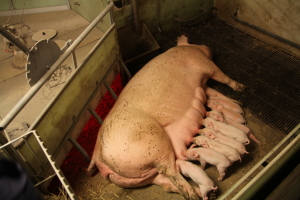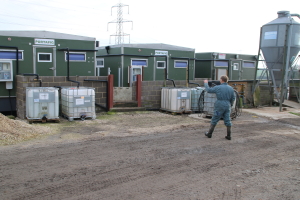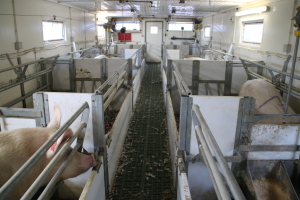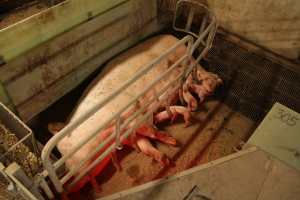


 Welfare issues are increasingly being highlighted through the media and elsewhere as consumers express concerns about how pigs are reared.
Welfare issues are increasingly being highlighted through the media and elsewhere as consumers express concerns about how pigs are reared.
Here in the UK back in the late 1960s we put gestating sows into sow stalls – and tethers – so that these pigs were unable to fight and each had her own space. More recently consumers and welfarists looked on stalls as cruel and such systems are banned totally and partially in many countries and producers have had to learn, whether they like it or not, how to manage gestating sows loose housed in groups.
The farrowing crate is now under close scrutiny and in fact has been banned in Norway, Sweden and Switzerland.
Consumers and welfarists view the farrowing crate as cruel, with the sow being tightly confined (for good reason) and unable to exhibit her nest building instincts. What these folk tend to forget is that the crate protects the piglets from being crushed or severely injured, which has to be a positive welfare feature from the piglet’s point of view. Again, the wheel turns full circle.
In 1967, the author’s research project for his degree compared farrowing performance of sows kept outdoors, farrowing in arks, with the then new concept of sows farrowing indoors. The sow was housed in the “farrowing pen” and was restrained by a rectangular tubular gate, which was subsequently opened three to four days post farrowing. Fast forward to 2015 and this concept has formed the basis of SWAP (Sow Welfare and Piglet Protection) pen.
The SWAP pen, which is being sold by many leading equipment companies, mainly in Europe, is dual purpose. It can be completely open, allowing the sow to farrow totally unrestrained, or one side converts into a farrowing crate which can then be swung open 48 hours after the piglets have been born, by which this time the piglets are alert and strong enough to be able to avoid overlaying. The SWAP pen is a very ingenious invention in that it can be used in three different ways:
*As a conventional farrowing crate
*As a crate but opening after 48 hours
*As a totally unrestricted free farrowing option
Hence if a producer was considering building a new farrowing facility which would be expected to last for many years then he could go ahead with the knowledge that if farrowing crates were banned totally or partially, then the SWAP pen could be used as a crate – free system.
Around 40 per cent of UK pigs are produced outdoors and the packaging of pork products in supermarkets often shows sows in outdoor paddocks, conveying an image of high welfare production. The RSPCA has a high welfare food label, Freedom Foods, which attracts a premium and indoor producers can also gain Freedom Foods accreditation. One area that is being reviewed is that of the farrowing pen, whereby current penning standards may not meet the pending new set of regulations. In 2014, the RSPCA expressed concerns about certain farrowing pens that did not provide any additional space above that provided by the size of the footprint of a traditional farrowing crate. The new regulations will come into force in December 2015. Two key changes include providing a bedded lying area that measures at least 2.8 square metres (this excludes any creep area) and ensuring that the minimum total pen size, including the lying area/nest area must be at least five square metres. “An inability to separate the lying area/ nest area is likely to result in increased activity which could increase the risk of piglet crushing by the sow”.
Also, having a pen area of a minimum of five square metres enables the sow to satisfy her nest site seeking behavioural needs. The pen construction has also caused concern. The RSPCA insists on total non-confinement of the sow and has expressed concerns about some types of “hinged crate” systems and that these must be welded so that they are permanently open.
Martin Barker is a very well-known UK pig producer and he has designed a very ingenious farrowing system, called the 360 farrower which is a type of SWAP pen. Unlike many other pens on the market the 360 farrower is quite small, measuring 2.5 m x 1.8 m. The 360 farrower is sold by Finrone Systems Ltd, based in N. Ireland. Finrone specializes in making containerized pig buildings, complete with built in effluent tanks which are delivered on site and placed on to a prepared base. Thereafter they only need hooking up to mains water and electricity and the producer has a ready- to -go piggery. Being portable they can be moved on to other sites if need be and have a good resale value. The dimensions of the 360 farrower mean that a standard container can be fitted with two rows of x units separated by an 820cm wide central access passage.
One of Finrone’s customers is Robert Lasseter and runs a 100ha mixed farm in Dorset, England. All the arable work is contracted out allowing Lasseter and his staff of three to look after 200 sows and progeny. Some years ago Lasseter had all his pigs outside but in 2012 decided to move his pigs indoors. He was attracted to the Freedom Foods scheme and so invested in a number of Finrone containers. His largest container houses sixteen 360s, although Finrone now make wider units which can take 22 farrowers. Lasseter runs a closed herd and so can select replacements from sows showing good mothering ability. Chopped newspaper is used as bedding and this also allows sows and gilts to exhibit a degree of nest building. Heat pads are fitted and these attract the piglets away from their mother. Pre-weaning mortality runs at 17 per cent, which is much higher than losses from conventional crated units, although this is compensated by the premium he receives from Freedom Foods.
Twenty four females farrow in three weekly batches producing a 20 tonne truckload of pigs (244x 80kg) which are slaughtered locally. Lasseter likes flexibility in his farming and all his growers and finishers are housed on straw, in sheds which could revert to housing cattle. In fact the only other specialist pig building on the farm is a second hand weaner house.
The Danes are increasingly welfare conscious and a 1200 sow unit in Jutland built in 2013 and owned by Niels Aage Arve is used as test bed for different farrowing systems, namely free farrowing and SWAP pens. Pre-weaning mortality is running at 19 per cent (from 16.9 pigs born alive / litter). This is not economic commented Arve as he does not get a carcase premium to compensate for the high mortality.
Free farrowing was high on the agenda at a major international welfare conference held in Copenhagen in April 2015. The concept has a lot of support and naturally there are concerns that the welfare lobby will push to get farrowing crates banned in the EU, following what has happened with gestation stalls.
However reassurances were given that this would not be considered until pre-weaning losses in free systems matched those currently being achieved in conventional farrowing pens. Breeders are hence giving mothering ability a much higher weighting in breeding programmes to reduce clumsiness in sows, which in time will result in sows being able to rear bigger litters whilst not being restrained in a farrowing crate. •
— By Norman Crabtree




